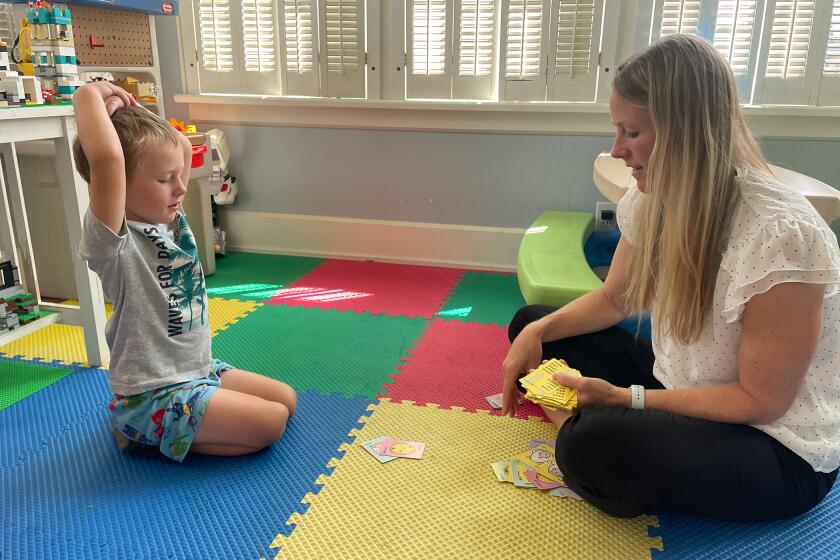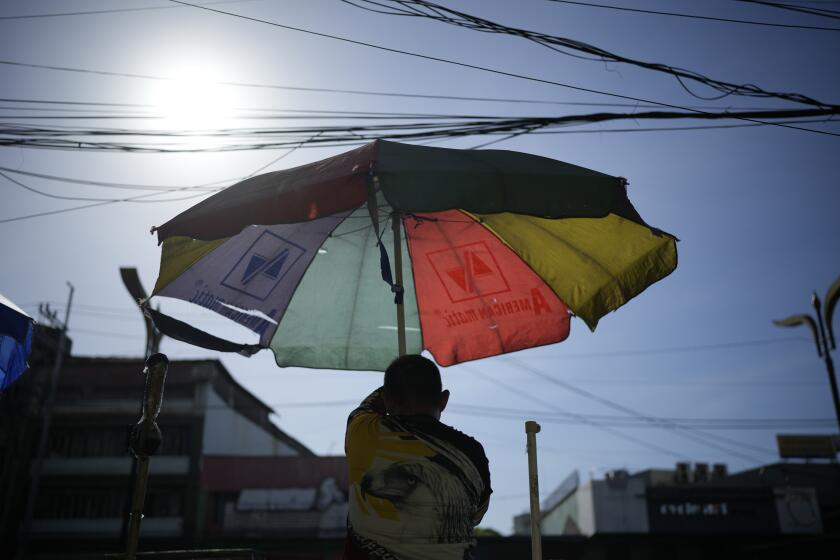Colombia Aims to End Civil War by Ceding Rebels Land
On a bustling Saturday afternoon in this river town cut from the jungle, music blares from the open-air bars where men in straw cowboy hats flirt with waitresses. Pickup trucks honk at cruising motor scooters that block the dirt streets.
Lately, a new sound has been added to the mix: the thump of helicopters overhead. Townsfolk believe the flights signal that the 2,000-soldier Cazadores (Hunters) Battalion, based four miles away, has begun to evacuate.
President Andres Pastrana recently confirmed that troops have begun pulling out of five cattle-ranching and cocaine-producing townships, including San Vicente. They will be gone by Nov. 7, ceding a territory the size of West Virginia to the guerrillas they have been fighting for nearly four decades.
The military evacuation is part of a monumental effort to end Colombia’s civil war and thus keep the top campaign promise of Pastrana, who was inaugurated in August. These initial steps toward peace, and their effects on Colombia’s war on drugs and the country’s political stability, are expected to lead the agenda when Pastrana meets today with President Clinton as part of the first state visit to Washington by a Colombian president in 26 years.
Pastrana is expected to tell Clinton that his nation is making significant progress toward peace, which in turn could break the alliance between drug traffickers and guerrilla armies that has strengthened both at the expense of this country.
Still, Pastrana’s willingness to accept such unorthodox preconditions as surrendering territory to rebels has raised fears that he may ultimately preside over the nation’s disintegration into fiefdoms run by warlords thinly disguised as insurgents or crusaders against insurgents.
The outcome is hard to predict in a peace process that will be unlike others in Latin America: More armed groups and more money are involved, and international agencies, at least initially, appear to have much less say. So, not surprisingly, the beginning also has been different.
In the name of peace, officials granted two imprisoned guerrilla leaders five-day passes to attend preliminary talks earlier this month in northern Colombia, and they are already considering a prisoner exchange--452 captured rebels for 249 soldiers held by insurgents.
The government appears so eager to begin talks with the country’s three rebel groups that one well-known comedian said he had discovered the administration’s secret negotiating strategy. He carefully unfolded a paper that read in bold letters: “Yes, sir.”
Two years of humiliating military defeats by the rebels, combined with strong public pressure to end the fighting, have left the government with little choice but to give in to demands by the guerrillas in order to get them to the negotiating table, said Alfredo Rangel, author of “War at the End of the Century,” a recently published book that analyzes Colombia’s civil war.
Hopes that talks can end the increasingly brutal conflict are edged with fears about the unusual compromises made by the Pastrana government to get negotiations started--particularly its decision to pull troops out of this area.
Guerrillas call their soon-to-be territory “a laboratory for peace.” But it is a laboratory that contains 10% of Colombia’s cocaine production, one of South America’s richest nature preserves and about 100,000 peasants, many now fearful for their lives. The experiments will test the sincerity of the rebels’ desire to negotiate peace.
Doubts about the insurgents’ willingness were raised by their refusal to declare a truce during the talks. The concerns were magnified this month when an oil fire started by the guerrilla bombing of a pipeline killed 62 people in two northern villages.
Still, risky as clearing troops from this southern region may be, the move is absolutely necessary, say former guerrillas, local church leaders and security experts. The rebels need a place where they can safely show themselves in order to be able to negotiate, those observers argue.
Rangel believes that insurgents want to use the area as a bully pulpit for their political and social views, not turn it into a narco-state, as some U.S. politicians have suggested. U.S. and Colombian officials note that because the region is beyond range of the small planes used to fumigate narcotics crops, it has never been part of eradication efforts.
In fact, Colombian officials insist that, as a first step toward peace, the troop withdrawal is part of an important blow to the drug trade. “To think that we can get rid of drugs without making peace is utopian,” Foreign Minister Guillermo Fernandez de Soto recently told international reporters.
A U.S. official agreed. “At the final stage, peace means a serious blow to drug trafficking, but . . . it will take some time.”
Colombian guerrillas “tax” narcotics production in return for protecting drug crops. Over the past decade, Colombia has become the world’s top cocaine producer--accounting for about 80% of all cocaine--and is now believed to be the third-largest heroin source.
Meanwhile, the insurgents’ cut from drug production has been a major factor in turning them from ragtag bands totaling fewer than 1,000 rebels with a presence in 170 of Colombia’s 1,061 townships into well-armed fighting forces of nearly 12,000 that operate in 600 townships and control many of them.
Peace, combined with a successful program to re-integrate the rebels into society, would eliminate the guerrillas as security guards for drug traffickers. However, one diplomat noted dryly, “Drug traffickers have other ways of protecting themselves.”
Still, both residents and experts say that the troop evacuation merely recognizes the truth: The rebels run these townships.
“The guerrillas have a presence in most of Caqueta [the province where San Vicente is located], and most mayors here receive pressure from the guerrillas,” said provincial Gov. Raul Castro. The rebels push mayors to spend most of their township budgets in ways that favor rebel supporters, he explained.
Ranchers sipping beer on a recent Saturday night at the Delicias del Pan cafe here said the “hunters” at the army battalion nearby do not often go hunting the guerrillas, who enforce their “war taxes” with the threat of kidnapping.
“The army is just another bunch of bums that don’t want to work,” said Rodrigo Vidal Perdomo, who owns a pharmacy in town and a 1,200-acre cattle ranch.
The rebels have already “evacuated the army at gunpoint,” said Antonio Navarro Wolf, a congressman who was among the chief rebel negotiators when the M-19 guerrilla movement laid down its arms in 1990. “The withdrawal is only a formality.”
But experts warn that this could be the beginning of the formal breakup of Colombia into semi-feudal states run by Marxist guerrillas, private armies and drug traffickers, reducing the government’s jurisdiction to a shrinking Andean triangle formed by the country’s three major cities: Bogota, Medellin and Cali.
Initially, the government has agreed to evacuate the army for 90 days, but most experts and participants expect that to be extended for two years or longer. “If the guerrillas want to create a laboratory for peace, they are not going to do that in 90 days,” said Father Leonel Narvaez, a local priest who often visits outlying hamlets.
“The evacuated area will be a knife pointed straight at Bogota,” a direct challenge to the national government, he warned.
Local leaders complain that the national government has not explained how it will protect their banks and credit unions from the rebels, or their lives from guerrillas and the private armies that have vowed to destroy the insurgents.
Even with the army present in 1996 and 1997, insurgents killed more than half a dozen government officials and peasant leaders in Caqueta. Two of the province’s mayors are in rebel custody, one of them kidnapped this month.
The road between the town of San Vicente and the provincial capital, Florencia, is littered with the burned carcasses of cars whose drivers dared defy a curfew that rebels imposed without explanation four months ago. With the guerrillas in control, citizens wonder what to expect.
An unknown number of people have already fled, joining the more than 1 million Colombians forced from their homes by war. Those who have stayed worry that even if they survive the insurgent regime, living in a rebel-controlled area will make them targets for the private armies, called self-defense forces, that wealthy landowners hired to combat the insurgents--mainly by killing civilians suspected of supporting the guerrillas.
The self-defense forces control large swaths of northern Colombia, where attacks by them Sunday left at least 21 people dead. Graffiti the killers left at the site of one attack called Pastrana’s concessions to the rebels “shameful.”
Now, the self-defense forces are thought to be grouping here in the south on the border that separates the five townships from the rest of Colombia.
Father Narvaez noted: “What is totally up in the air is what is going to happen in the period of limbo between when the army leaves and the guerrillas take over. It will take 10 to 15 days for [the guerrillas] to verify that the troops are gone. During that time, the population is going to be completely exposed.”
In order to get answers, the mayors of the five townships have organized the Assn. of Townships for the Troop Evacuation. The association includes mayors representing the mainstream Liberal and Conservative parties along with the rebel-linked Patriotic Union and a civic movement.
“We will not be involved in the negotiations,” said Javier Munera, the group’s technical secretary. “We are organizing community meetings to prepare the population.” The first such meeting, earlier this month, attracted 1,000 people, he said.
Overcoming their fears, people in this neglected area of Colombia also are filled with hope and pride, said Narvaez. “We have a historic responsibility to provide fertile land for peace, so that the seed can grow here in San Vicente,” he said.
“This is a very difficult road and a long one,” Gov. Castro said of the peace process. “And for that very reason, we need to get started.”
More to Read
Start your day right
Sign up for Essential California for news, features and recommendations from the L.A. Times and beyond in your inbox six days a week.
You may occasionally receive promotional content from the Los Angeles Times.






